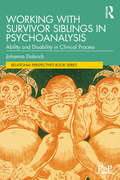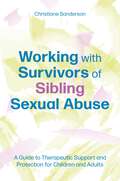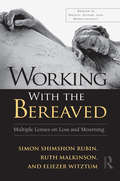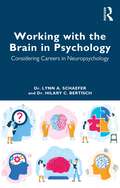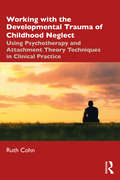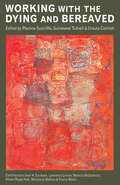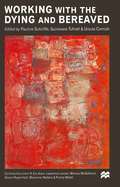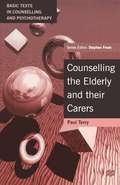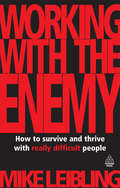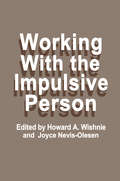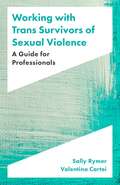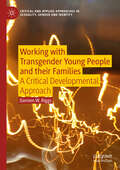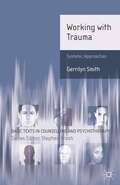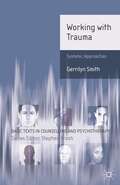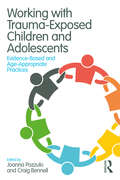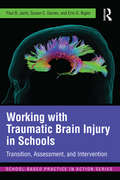- Table View
- List View
Working with Survivor Siblings in Psychoanalysis: Ability and Disability in Clinical Process (Relational Perspectives Book Series)
by Johanna DobrichWorking with Survivor Siblings in Psychoanalysis: Ability and Disability in Clinical Process explores a previously neglected area in the field of psychoanalysis, addressing undertheorized concepts on siblings, disabilities and psychic survivorship, and broadening our conceptualization of the enduring effects of lateral relations on human development. What happens to a person’s sense of self both personally and professionally when they grow up alongside a severely disabled sibling? Through a series of qualitative interviews held between the author and a sample of psychoanalysts, this book examines both the unconscious experience and the interpersonal field of survivor siblings. Through a trauma-informed contemporary psychoanalytic lens, Dobrich combines data analysis, theory-building, memoir, and clinical storytelling to explore and explicate the impact of lateral survivorship on the clinical moment, making room for a contemporary and nuanced appreciation of siblings in psychoanalysis. Working with Survivor Siblings in Psychoanalysis: Ability and Disability in Clinical Process, will be of immense interest and value to psychoanalysts and other mental health professionals, and for all therapists who work with and treat patients that are themselves survivor siblings. Uniquely integrating both academic and memoir writing, this book will also engage those building theory around the implications of the analyst’s subjectivity on clinical processes.
Working with Survivors of Sibling Sexual Abuse: A Guide to Therapeutic Support and Protection for Children and Adults
by Christiane SandersonSibling sexual abuse is considered to be one of the most common forms of child sexual abuse within the family setting, yet it is often ignored, downplayed or denied in spite the impact on survivors. Shining a spotlight on the hidden phenomenon, Christiane Sanderson provides a rigorous account of the nature and dynamics of sibling sexual abuse. She provides a clear explanation of the difference between developmentally appropriate, consensual sexual exploration and developmentally inappropriate, non-consensual sexual behaviour. The focus is on how these behaviours impact the sibling being harmed, the sibling who is harming, the wider family and adult survivors. This book is essential reading for anyone involved in assessing, supporting, safeguarding or treating individuals or families impacted by sibling sexual abuse and all those working with adult survivors.
Working with Survivors of Sibling Sexual Abuse: A Guide to Therapeutic Support and Protection for Children and Adults
by Christiane SandersonSibling sexual abuse is considered to be one of the most common forms of child sexual abuse within the family setting, yet it is often ignored, downplayed or denied in spite the impact on survivors. Shining a spotlight on the hidden phenomenon, Christiane Sanderson provides a rigorous account of the nature and dynamics of sibling sexual abuse. She provides a clear explanation of the difference between developmentally appropriate, consensual sexual exploration and developmentally inappropriate, non-consensual sexual behaviour. The focus is on how these behaviours impact the sibling being harmed, the sibling who is harming, the wider family and adult survivors. This book is essential reading for anyone involved in assessing, supporting, safeguarding or treating individuals or families impacted by sibling sexual abuse and all those working with adult survivors.
Working With the Bereaved: Multiple Lenses on Loss and Mourning (Series in Death, Dying, and Bereavement)
by Simon Shimshon Rubin Ruth Malkinson Eliezer WitztumWorking With the Bereaved summarizes the major themes in bereavement research and clinical work and uses the authors’ own cutting-edge research to show mental-health practitioners how to integrate these themes into their practice. It provides clinicians with a framework for exploring their own emotional and intellectual assumptions about loss and bereavement, and it goes on to summarize state-of-the-art thinking in the field. The heart of the book focuses on the theoretical and clinical implications of the empirically validated Two-Track Model of Bereavement, as well as a variety of therapeutic techniques designed to help the bereaved both reapproach life and manage their continuing bonds with the deceased. The later chapters examine methods for integrating systems and family perspectives in therapy, for attending to the implications of culture and religion, and for meeting crises and emergencies in bereavement care. The concluding chapter addresses self-care, well-being, and resilience, offering practical guidelines for both the bereaved and those who treat them.
Working With the Bereaved: Multiple Lenses on Loss and Mourning (Series in Death, Dying, and Bereavement)
by Simon Shimshon Rubin Ruth Malkinson Eliezer WitztumWorking With the Bereaved summarizes the major themes in bereavement research and clinical work and uses the authors’ own cutting-edge research to show mental-health practitioners how to integrate these themes into their practice. It provides clinicians with a framework for exploring their own emotional and intellectual assumptions about loss and bereavement, and it goes on to summarize state-of-the-art thinking in the field. The heart of the book focuses on the theoretical and clinical implications of the empirically validated Two-Track Model of Bereavement, as well as a variety of therapeutic techniques designed to help the bereaved both reapproach life and manage their continuing bonds with the deceased. The later chapters examine methods for integrating systems and family perspectives in therapy, for attending to the implications of culture and religion, and for meeting crises and emergencies in bereavement care. The concluding chapter addresses self-care, well-being, and resilience, offering practical guidelines for both the bereaved and those who treat them.
Working with the Brain in Psychology: Considering Careers in Neuropsychology
by Lynn A. Schaefer Hilary C. BertischWorking with the Brain in Psychology: Considering Careers in Neuropsychology seeks to assist students in their career exploration, by introducing them early, in the contemplative stage of career planning, to the fascinating speciality of psychology known as neuropsychology. The text spends considerable time differentiating neuropsychology from alternative career paths, and provides personal accounts, contributions from neuropsychologists in various settings, and case examples of different patient populations to illustrate what it is like to train to become and work as a neuropsychologist. This text begins by describing what neuropsychology is, how it is situated within psychology, and for whom it could be a good fit. Suggestions are provided about how to engage in self-assessment in order to help choose a career. It goes on to review over a dozen similar and overlapping careers to illustrate how neuropsychology stands out. Quotes by professional neuropsychologists bring to life what "a day in the life" looks like in different settings, and the kinds of populations with whom neuropsychologists work are illustrated with case examples. This book then outlines how one becomes a neuropsychologist, including how to re-specialize from a different field. It also gives an honest appraisal of potential challenges that come with this career, and ends with anticipated future directions in the profession to look forward to. This book will be useful primarily for psychology-minded undergraduates and college graduates thinking of going on to graduate school for psychology, as well as for high school students interested in the brain and psychology. This book is further aimed at those considering a change of career from a related field into neuropsychology, as well as the guidance counselors and college career centers that assist with career planning.
Working with the Brain in Psychology: Considering Careers in Neuropsychology
by Lynn A. Schaefer Hilary C. BertischWorking with the Brain in Psychology: Considering Careers in Neuropsychology seeks to assist students in their career exploration, by introducing them early, in the contemplative stage of career planning, to the fascinating speciality of psychology known as neuropsychology. The text spends considerable time differentiating neuropsychology from alternative career paths, and provides personal accounts, contributions from neuropsychologists in various settings, and case examples of different patient populations to illustrate what it is like to train to become and work as a neuropsychologist. This text begins by describing what neuropsychology is, how it is situated within psychology, and for whom it could be a good fit. Suggestions are provided about how to engage in self-assessment in order to help choose a career. It goes on to review over a dozen similar and overlapping careers to illustrate how neuropsychology stands out. Quotes by professional neuropsychologists bring to life what "a day in the life" looks like in different settings, and the kinds of populations with whom neuropsychologists work are illustrated with case examples. This book then outlines how one becomes a neuropsychologist, including how to re-specialize from a different field. It also gives an honest appraisal of potential challenges that come with this career, and ends with anticipated future directions in the profession to look forward to. This book will be useful primarily for psychology-minded undergraduates and college graduates thinking of going on to graduate school for psychology, as well as for high school students interested in the brain and psychology. This book is further aimed at those considering a change of career from a related field into neuropsychology, as well as the guidance counselors and college career centers that assist with career planning.
Working with the Developmental Trauma of Childhood Neglect: Using Psychotherapy and Attachment Theory Techniques in Clinical Practice
by Ruth CohnThis book provides psychotherapists with a multidimensional view of childhood neglect and a practical roadmap for facilitating survivors’ healing. Working from a strong base in attachment theory, esteemed clinician Ruth Cohn explores ways therapists can recognize the signs of childhood neglect, provides recommendations for understanding lasting effects that can persist into adulthood, and lays out strategies for helping clients maximize therapeutic outcomes. Along with extensive clinical material, chapters introduce skills that therapists can develop and hone, such as the ability to recognize and discern non-verbal attempts at communication. They also provide an array of resources and evidence-based treatment modalities that therapists can use in session. Working with the Developmental Trauma of Childhood Neglect is an essential book for any mental health professional working with survivors of childhood trauma.
Working with the Developmental Trauma of Childhood Neglect: Using Psychotherapy and Attachment Theory Techniques in Clinical Practice
by Ruth CohnThis book provides psychotherapists with a multidimensional view of childhood neglect and a practical roadmap for facilitating survivors’ healing. Working from a strong base in attachment theory, esteemed clinician Ruth Cohn explores ways therapists can recognize the signs of childhood neglect, provides recommendations for understanding lasting effects that can persist into adulthood, and lays out strategies for helping clients maximize therapeutic outcomes. Along with extensive clinical material, chapters introduce skills that therapists can develop and hone, such as the ability to recognize and discern non-verbal attempts at communication. They also provide an array of resources and evidence-based treatment modalities that therapists can use in session. Working with the Developmental Trauma of Childhood Neglect is an essential book for any mental health professional working with survivors of childhood trauma.
Working with the Dying and Bereaved: Systemic Approaches to Therapeutic Work
by Pauline Sutcliffe Guinevere Tufnell Ursula CornishFirst published in 1998. Working with the Dying and Bereaved illustrates how therapists can use a systemic approach to help families facing death and bereavement. This approach considers the individual in a broader, more holistic concept than traditional theories. This book provides a broad theoretical framework and practical strategies for systemic therapeutic work. Each chapter demonstrates how each approach has been applied by the therapist to work within a particular model, carefully outlining the particular technique used.
Working with the Dying and Bereaved: Systemic approaches to therapeutic work
Coping with death and dying involves much more than learning to live with grief. Working with the Dying and Bereaved illustrates how therapists can use a 'systemic' approach to help families facing death and bereavement. This approach considers the individual in a broader, more holistic context than traditional theories.This book provides both a broad theoretical framework and practical strategies for systemic therapeutic work. Each chapter demonstrates how the approach has been applied by the therapist to work within a particular model, each with its characteristic techniques. The therapist's role and interventions are explained, showing how, why and when particular interventions are made. The processes described can help the therapist to manage both in the acute situation and in identifying needs that may call for follow-up and longer term work.
Working with the Dying and Bereaved: Systemic Approaches to Therapeutic Work
First published in 1998. Working with the Dying and Bereaved illustrates how therapists can use a systemic approach to help families facing death and bereavement. This approach considers the individual in a broader, more holistic concept than traditional theories. This book provides a broad theoretical framework and practical strategies for systemic therapeutic work. Each chapter demonstrates how each approach has been applied by the therapist to work within a particular model, carefully outlining the particular technique used.
Working with the Elderly and their Carers (Basic Texts in Counselling and Psychotherapy)
by Paul TerryTaking a psychodynamic approach, Counselling the Elderly and their Carers draws on psychoanalytical ideas and their application to individuals, groups, institutions and society, providing a unique insight into the increasingly important area of working with the elderly and their carers. Focusing on understanding the unconscious as well as the conscious experience of being elderly and frail, it addresses issues such as retirement, deteriorating physical illness and death. The importance of the carer is recognised in this book, and includes accounts of working with individual staff in their role as keyworkers for particular patients - work which sheds light on the care-giving relationship, its rewards and frustrations, as well as on how abusive practices may develop between carer and patient. There is a description of working with carers in a support group; working with managers of a long-stay hospital; and of meetings between elderly patients and staff on long-stay wards.This book is aimed at readers who wish to be introduced to the theory and practice of counselling and psychotherapy in this area. It will appeal to a wide range of professionals, including counsellors, therapists, nurses, social workers, doctors and geriatricians, and will prove invaluable to both qualified professionals and students.
Working with the Enemy: How to Survive and Thrive with Really Difficult People (Kogan Page Ser.)
by Mike LeiblingWorking With The Enemy is, quite simply, for people who have been feeling 'under attack' and want to do something about it, once and for all. Showing you how to turn around 'enemy' situations so that you can take control, it includes 10 essential survival strategies, descriptions of the 15 toughest types of enemy and tips on how to transform your enemy situation.The reader will be able to recognize how exactly they came to find these 'enemies' to be 'really difficult', deal with them and nip future situations in the bud before they become 'difficult'.Working With The Enemy treats difficult situations in a matter-of-fact way and the many case studies, tips, techniques and strategies will help you to unstick yourself when you've been feeling very stuck.
Working with the Enemy: How to Survive and Thrive with Really Difficult People
by Mike LeiblingWorking With The Enemy is, quite simply, for people who have been feeling 'under attack' and want to do something about it, once and for all. Showing you how to turn around 'enemy' situations so that you can take control, it includes 10 essential survival strategies, descriptions of the 15 toughest types of enemy and tips on how to transform your enemy situation.The reader will be able to recognize how exactly they came to find these 'enemies' to be 'really difficult', deal with them and nip future situations in the bud before they become 'difficult'.Working With The Enemy treats difficult situations in a matter-of-fact way and the many case studies, tips, techniques and strategies will help you to unstick yourself when you've been feeling very stuck.
Working with the Impulsive Person
by Howard A. Wishnie and Joyce Nevis-OlesenThe development of the material in this volume began with a realization by the staff at The Cambridge-Somerville Mental Health and Retardation Center (in the Massachusetts cities of Cambridge and Somerville) that an increasing num ber of people were entering the mental health system with problems related to the very nature of their personalities. A significant number of these people presented issues that had not been identified previously within the spectrum of psychiatric treatment. Such issues as marital discord in volving impulsive and violent behavior toward spouses or children, drug abuse, alcoholism, brawling, and so forth were increasingly being viewed as symptomatic of disruptions in an individual's emotional makeup. These people usually did not seek treatment; their problems were most often managed by courts and social welfare agencies. In fact, we were not clear as to what constituted the best treatment. The conference on which this book is based was conceived of as an attempt to bring together people of varying back grounds to discuss in a general, nontechnical fashion the approaches they have tried in working with such people. We attempted to bridge the gap between the many sophisticated theorists who work in this area and the front-line personnel who daily confront these problems. Because of the general scope of the conference, the papers covered a wide range of issues and experiences.
Working with Trans Survivors of Sexual Violence: A Guide for Professionals
by Sally Rymer Valentina CarteiThis book provides practical advice for professionals working with transgender (including non-binary) people who have survived any form of sexual violence or abuse. It gives professionals an understanding of the impact and trauma of sexual violence on trans people, as well as the additional difficulties they face accessing services that have traditionally been designed to serve cisgendered clients.The authors reveal specific issues faced by trans people as they recover from traumatic sexual experiences, and what steps professionals and organisations can take to meet the needs of the trans community. They also take a critical look at what can be done to reduce discrimination, particularly as many services for sexual violence tend to enforce strict gender segregation which can be exclusionary for trans clients. This book helps mitigate the traumatic effects of sexual violence on trans individuals, by recommending effective responses for all levels of service delivery, from organisational policies to advice for front-line professionals.
Working with Trans Survivors of Sexual Violence: A Guide for Professionals
by Sally Rymer Valentina CarteiThis book provides practical advice for professionals working with transgender (including non-binary) people who have survived any form of sexual violence or abuse. It gives professionals an understanding of the impact and trauma of sexual violence on trans people, as well as the additional difficulties they face accessing services that have traditionally been designed to serve cisgendered clients.The authors reveal specific issues faced by trans people as they recover from traumatic sexual experiences, and what steps professionals and organisations can take to meet the needs of the trans community. They also take a critical look at what can be done to reduce discrimination, particularly as many services for sexual violence tend to enforce strict gender segregation which can be exclusionary for trans clients. This book helps mitigate the traumatic effects of sexual violence on trans individuals, by recommending effective responses for all levels of service delivery, from organisational policies to advice for front-line professionals.
Working with Transgender Young People and their Families: A Critical Developmental Approach (Critical and Applied Approaches in Sexuality, Gender and Identity)
by Damien W. RiggsWorking with Transgender Young People and their Families advocates a critical developmental approach aimed at countering the cisgenderism that can be perceived in previous developmental literature on gender. It clears a path to understanding gender development for transgender young people by providing a detailed account that spans early childhood through to late adolescence. In doing so, it demonstrates how clinicians can work more effectively with parents and other family members in order to affirm transgender young people. By outlining a GENDER mnemonic created by the author, the book provides worked through examples of case materials that highlight the benefits of a critical developmental approach. Offering unique insights and practical guidance, it provides a cutting-edge resource for clinicians and researchers, as well as for families and other professionals seeking to understand and work affirmingly with transgender young people.
Working with Trauma: Systemic Approaches (Basic Texts in Counselling and Psychotherapy)
by Gerrilyn SmithThe toxic nature of trauma can make it an overwhelming area of work. This book by a recognised expert adopts a systemic perspective, focusing on the individual in context. Very positively, it shows how every level of relationship can contribute to healing and that the meaning of traumatic experiences can be 'unfrozen' and revisited over time.
Working with Trauma: Systemic Approaches (Basic Texts in Counselling and Psychotherapy)
by Gerrilyn SmithThe toxic nature of trauma can make it an overwhelming area of work. This book by a recognised expert adopts a systemic perspective, focusing on the individual in context. Very positively, it shows how every level of relationship can contribute to healing and that the meaning of traumatic experiences can be 'unfrozen' and revisited over time.
Working with Trauma-Exposed Children and Adolescents: Evidence-Based and Age-Appropriate Practices
by Joanna Pozzulo Craig BennellFar too often, children and youth experience trauma, from rare events such as mass shootings, terrorism attacks, and school lockdowns, to very common occurrences such as bullying, exposure to drugs and alcohol, or various mental health issues. They can experience these events both directly and indirectly (from surfing the internet, watching television, or through their friends). Our children spend a large portion of their day at school interacting with other students, teachers, and school personnel, where these topics are raised and discussed. This edited volume addresses how our teachers and school personnel can help students deal with these potentially traumatic events to reach the most positive possible outcomes. This collection brings together leading experts, including academics and professionals working in the field, to provide the most current evidence-based practices on how to help students who may have experienced or witnessed trauma. It presents research and advice on how to respond to traumatic events regarding bullying; drugs and alcohol; sexual abuse; mental health; lesbian, gay, bisexual, transgender, and queer (LGBTQ) safety; stranger danger; childhood disruptive behaviors; school shootings and lockdowns; and terrorism. It also includes a chapter focused on how to implement a school safety program. Schools cannot deal with these issues alone; effective strategies must engage family members and the broader community. Hence, the collection includes a chapter on how schools can partner with families and the communities they reside in to bring about positive change. All this work pays close attention to cultural and religious sensitivity, socio-economic variabilities, diversity issues, and developmental stages.
Working with Trauma-Exposed Children and Adolescents: Evidence-Based and Age-Appropriate Practices
by Joanna Pozzulo Craig BennellFar too often, children and youth experience trauma, from rare events such as mass shootings, terrorism attacks, and school lockdowns, to very common occurrences such as bullying, exposure to drugs and alcohol, or various mental health issues. They can experience these events both directly and indirectly (from surfing the internet, watching television, or through their friends). Our children spend a large portion of their day at school interacting with other students, teachers, and school personnel, where these topics are raised and discussed. This edited volume addresses how our teachers and school personnel can help students deal with these potentially traumatic events to reach the most positive possible outcomes. This collection brings together leading experts, including academics and professionals working in the field, to provide the most current evidence-based practices on how to help students who may have experienced or witnessed trauma. It presents research and advice on how to respond to traumatic events regarding bullying; drugs and alcohol; sexual abuse; mental health; lesbian, gay, bisexual, transgender, and queer (LGBTQ) safety; stranger danger; childhood disruptive behaviors; school shootings and lockdowns; and terrorism. It also includes a chapter focused on how to implement a school safety program. Schools cannot deal with these issues alone; effective strategies must engage family members and the broader community. Hence, the collection includes a chapter on how schools can partner with families and the communities they reside in to bring about positive change. All this work pays close attention to cultural and religious sensitivity, socio-economic variabilities, diversity issues, and developmental stages.
Working with Traumatic Brain Injury in Schools: Transition, Assessment, and Intervention (School-Based Practice in Action)
by Paul B. Jantz Susan C. Davies Erin D. BiglerEvery day, children and adolescents worldwide return to the educational setting having sustained a traumatic brain injury (TBI). The possible negative consequences of TBI range from mild to severe and include neurological, cognitive, emotional, social, and behavioral difficulties. Within the school setting, the negative effects of TBI tend to persist or worsen over time, often resulting in academic and social difficulties that require formal and informal educational assistance and support. School psychologists and other educational professionals are well-positioned to help ensure students with TBI receive this assistance and support. Working with Traumatic Brain Injury in Schools is a comprehensive practitioner-oriented guide to effective school-based services for students who have experienced a TBI. It is primarily written for school-based professionals who have limited or no neurological or neuropsychological training; however, it contains educational information that is useful to professionals with extensive knowledge in neurology and/or neuropsychology. This book is also written for parents and guardians of students with TBI because of their integral role in the transition, school-based assessment, and school-based intervention processes. Chapter topics include: basic brain anatomy and physiology; head injury and severity level classifications; biomechanics of injury; injury recovery and rehabilitation; neurological, cognitive, emotional, behavioral, social, and academic consequences; understanding community-based assessment findings; a framework for school-based assessment (TBI-SNNAP); school-based psychoeducational report writing, and school-based interventions; monitoring pharmacological interventions; and prevention. An accompanying website includes handouts, sample reports, and training templates to assist professionals in recognizing and responding to students with TBI.
Working with Traumatic Brain Injury in Schools: Transition, Assessment, and Intervention (School-Based Practice in Action)
by Paul B. Jantz Susan C. Davies Erin D. BiglerEvery day, children and adolescents worldwide return to the educational setting having sustained a traumatic brain injury (TBI). The possible negative consequences of TBI range from mild to severe and include neurological, cognitive, emotional, social, and behavioral difficulties. Within the school setting, the negative effects of TBI tend to persist or worsen over time, often resulting in academic and social difficulties that require formal and informal educational assistance and support. School psychologists and other educational professionals are well-positioned to help ensure students with TBI receive this assistance and support. Working with Traumatic Brain Injury in Schools is a comprehensive practitioner-oriented guide to effective school-based services for students who have experienced a TBI. It is primarily written for school-based professionals who have limited or no neurological or neuropsychological training; however, it contains educational information that is useful to professionals with extensive knowledge in neurology and/or neuropsychology. This book is also written for parents and guardians of students with TBI because of their integral role in the transition, school-based assessment, and school-based intervention processes. Chapter topics include: basic brain anatomy and physiology; head injury and severity level classifications; biomechanics of injury; injury recovery and rehabilitation; neurological, cognitive, emotional, behavioral, social, and academic consequences; understanding community-based assessment findings; a framework for school-based assessment (TBI-SNNAP); school-based psychoeducational report writing, and school-based interventions; monitoring pharmacological interventions; and prevention. An accompanying website includes handouts, sample reports, and training templates to assist professionals in recognizing and responding to students with TBI.
